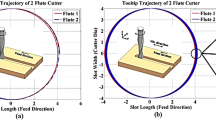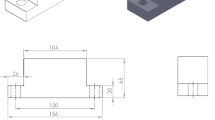Abstract
In this paper, statistical models were developed to investigate effect of cutting parameters on surface roughness and root mean square of work piece vibration in boring of stainless steel. A mixed level design of experiments was prepared with process variables of nose radius, cutting speed and feed rate. According to design of experiments, eighteen experiments were conducted on AISI 316 stainless steel with PVD coated carbide tools. Surface roughness, tool wear and vibration of work piece were measured in each experiment. A laser Doppler vibrometer was used to measure vibration of work piece in the form of acousto optic emission signals. These signals were processed and transformed in to different frequency zones using a fast Fourier transformer. Analysis of variance was used to identify significant cutting parameters on surface roughness and root mean square of work piece vibration. Predictive models like response surface methodology, artificial neural network and support vector machine were used to predict the surface roughness and root mean square of work piece vibration. Cutting parameters were optimized for minimum surface roughness and root mean square of work piece vibration using a multi response optimization technique.







Similar content being viewed by others
References
Adem, Ç., Turgay, K., & Ergün, E. (2015). Optimization of drilling parameters using Taguchi technique and response surface methodology (RSM) in drilling of AISI 304 steel with cryogenically treated HSS drills. Journal of Intelligent Manufacturing, 26(2), 295–305.
Ali, H. N., & Nader, A. N. (2012). Time-delay feedback control of lathe cutting tools. Journal of Vibration and Control, 18, 1106–1115.
Amit Kumar, G. (2010). Predictive modelling of turning operations using response surface methodology, artificial neural networks and support vector regression. International Journal of Production Research, 48(3), 763–778.
Angelos, P. M., Dimitrios, E. M., & Nikolaos, M. V. (2008). Artificial neural network models for the prediction of surface roughness in electrical discharge machining. Journal of Intelligent Manufacturing, 19(3), 283–292.
Ashvin, J. M., & Nanavati, J. I. (2013). Optimisation of machining parameters for turning operations based on response surface methodology. Measurement, 46(4), 1521–1529.
Azlan, M. Z., Habibollah, H., & Safian, S. (2012). Integrated ANN-GA for estimating the minimum value for machining performance. International Journal of Production Research, 50(1), 191–213.
Bhardwaj, B., Kumar, R., & Singh, P. K. (2014). Surface roughness (Ra) prediction model for turning of AISI 1019 steel using response surface methodology and Box-Cox transformation. Proceedings of Institute of Mechanical Engineering Part B: Journal of Engineering Manufacture, 228(2), 223–232.
Chang, F. X. (2001). An experimental study of the impact of turning parameters on surface roughness. In Proceedings of the industrial engineering research conference, Paper no. 2036, GA.
Dai, L., & Wang, J. (2007). The effects of workpiece deflection and motor features on quality of machining process—nonlinear vibrations analysis. Journal of Vibration and Control, 13, 557–582.
Del Castillo, E., & Montgomery, D. C. (1993). A nonlinear programming solution to the dual response problem. Journal of Quality Technology, 25, 199–204.
Derringer, G., & Suich, R. (1980). Simultaneous optimization of several response variables. Journal of Quality Technology, 12, 214–219.
Hosseini, S., & Al Khaled, A. (2014). A survey on the imperialist competitive algorithm metaheuristic: Implementation in engineering domain and directions for future research. Applied Soft Computing, 24, 1078–1094.
Hosseini, S., Barker, K., & Ramirez-Marquez, J. E. (2016). A review of definitions and measures of system resilience. Reliability Engineering and System Safety, 145, 47–61.
Ihsan, K., & Yilmaz, K. (2010). Experimental analysis of the deviation from circularity of bored hole based on the Taguchi method. Journal of Mechanical Engineering, 56(5), 340–346.
Ilhan, A., Mustafa, T., Hazim, E. M., & Levent, Ç. (2012). An intelligent system approach for surface roughness and vibrations prediction in cylindrical grinding. International Journal of Computer Integrated Manufacturing, 25(8), 750–759.
Khaled, A. A., & Hosseini, S. (2015). Fuzzy adaptive imperialist competitive algorithm for global optimization. Neural Computing and Applications, 26(4), 813–825.
Kishan, M., Chilukuri, K. M., & Sanjay, R. (1997). Elements of artificial neural networks. Cambridge: The MIT Press.
Lingxuan, Z., Zhenyuan, J., Fuji, W., & Wei, L. (2010). A hybrid model using supporting vector machine and multi-objective genetic algorithm for processing parameters optimization in micro-EDM. International Journal of Advanced Manufacturing Technology, 51, 575–586.
Marimuthu, P., & Chandrasekaran, K. (2011). Experimental study on stainless steel for optimal setting of machining parameters using Taguchi and neural network. ARPN Journal of Engineering and Applied Sciences, 6(10), 119–127.
Moetakef-Imani, B., & Yussefin, N. Z. (2009). Dynamic simulation of boring process. International Journal of Machine Tools and Manufacture, 49, 1096–1103.
Mohammadnejad, M., Gholami, R., Ramezanzadeh, A., & Jalali, M. E. (2012). Prediction of blast-induced vibrations in limestone quarries using support vector machine. Journal of Vibration and Control, 18, 1322–1329.
Montgomery, D. C. (2001). Design and analysis of experiments (5th ed.). New York: Wiley.
Mourad, L., Mustapha, B., Marc, T., & Mohamed, E. B. (2015). Chatter detection in milling machines by neural network classification and feature selection. Journal of Vibration and Control, 21, 1251–1266.
Murath, S., & Abdulkadir, G. (2014). Taguchi design and response surface methodology based analysis of machining parameters in CNC turning under MQL. Journal of Cleaner Production, 65, 604–616.
Muthukrishnan, N., & Paulo, D. J. (2009). Optimization of machining parameters of Al/SiC-MMC with ANOVA and ANN analysis. Journal of Material Processing Technology, 209(1), 225–232.
Nakagawa, H., Kurita, Y., Ogawa, K., Sugiyama, Y., & Hasegawa, H. (2008). Experimental analysis of chatter vibration in end-milling using laser Doppler vibrometers. International Journal of Automation Technology, 2(6), 431–438.
Nilrudra, M., Doloi, B., & Mondal, B. (2013). Predictive modeling of surface roughness in high speed machining of AISI 4340 steel using yttria stabilized zirconia toughened alumina turning insert. International Journal of Refractory Metals and Hard Materials, 38, 40–46.
Pettersson, L., Hakansson, L., & Claessonans Sven Olsson, I. (2001). Active control of machine-tool vibration in a CNC lathe based on an active tool holder shank with embedded piezo ceramic actuators. In The 8thInternational congress on sound and vibration, Hong Kong SAR, China, 2–6 July 2001.
Prasad, B. S., Sarcar, M. M. M., & Satish, B. B. (2010). Development of a system for monitoring tool conditionusing acousto-optic emission signal in face turning-an experimental approach. International Journal of Advanced Manufacturing Technology, 51, 57–67.
Rajesh, K. B. (2013a). Optimization of cutting parameters for minimizing power consumption and maximizing tool life during machining of Al alloy SiC particle composites. Journal of Cleaner Production, 39, 242–254.
Rajesh, K. B. (2013b). Multiresponse optimization of al alloy-SiC composite machining parameters for minimum tool wear and maximum metal removal rate. ASME, Journal of Manufacturing Science and Engineering,. doi:10.1115/1.4023454.
Ramesh, K., Alwarsamy, T., & Jayabal, S. (2015). Prediction of cutting process parameters in boring operations using artificial neural networks. Journal of Vibration and Control, 21, 1043–1054.
Ulaş, Ç., & Sami, E. (2012). Support vector machines models for surface roughness prediction in CNC turning of AISI 304 austenitic stainless steel. Journal of Intelligent Manufacturing, 23(3), 639–650.
Vadlamani, S., & Hosseini, S. (2014). A novel heuristic approach for solving aircraft landing problem with single runway. Journal of Air Transport Management, 40, 144–148.
Vapnik, V. (1998). Statistical learning theory. New York: Wiley Interscience.
Venkata Rao, K., Murthy, B. S. N., & Mohan Rao, N. (2013). Cutting tool condition monitoring by analyzing surface roughness, work piece vibration and volume of metal removed for AISI 1040 steel in boring. Measurement, 46, 4075–4084.
Venkata Rao, K., Murthy, B. S. N., & Mohan Rao, N. (2014). Prediction of cutting tool wear, surface roughness and vibration of work piece in boring of AISI 316 steel with artificial neural network. Measurement, 51, 63–70.
Yalcin, U., Aslan, D. K., & Ihsan, K. (1980). Optimization of cutting parameters in face milling with neural networks and Taguchi based on cutting force, surface roughness and temperatures. International Journal of Production Research, 18(5), 559–569.
Yao-Wen, H., & Chan-Yun, Y. (2008). Prediction of tool breakage in face milling using support vector machine. International Journal of Advanced Manufacturing Technology, 37, 872–880.
Yeh, Y., & Cummins, H. Z. (1964). Localized fluid flow measurements with a He–Ne laser spectrometer. Applied Physics Letters, 4, 176.
Author information
Authors and Affiliations
Corresponding author
Rights and permissions
About this article
Cite this article
Venkata Rao, K., Murthy, P.B.G.S.N. Modeling and optimization of tool vibration and surface roughness in boring of steel using RSM, ANN and SVM. J Intell Manuf 29, 1533–1543 (2018). https://doi.org/10.1007/s10845-016-1197-y
Received:
Accepted:
Published:
Issue Date:
DOI: https://doi.org/10.1007/s10845-016-1197-y




